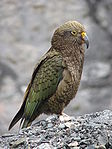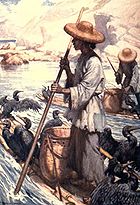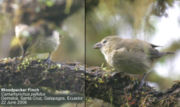
Bird intelligence
Encyclopedia

Intelligence
Intelligence has been defined in different ways, including the abilities for abstract thought, understanding, communication, reasoning, learning, planning, emotional intelligence and problem solving....
and its measurement as it applies to bird
Bird
Birds are feathered, winged, bipedal, endothermic , egg-laying, vertebrate animals. Around 10,000 living species and 188 families makes them the most speciose class of tetrapod vertebrates. They inhabit ecosystems across the globe, from the Arctic to the Antarctic. Extant birds range in size from...
s. Traditionally, birds have been considered inferior in intelligence to mammal
Mammal
Mammals are members of a class of air-breathing vertebrate animals characterised by the possession of endothermy, hair, three middle ear bones, and mammary glands functional in mothers with young...
s, and derogatory terms such as bird brains have been used colloquially in some cultures. Such perceptions are no longer considered scientifically valid. The difficulty of defining or measuring intelligence in non-human animals makes the subject difficult for scientific study. Anatomically, a bird has a relatively large brain compared to its head size. The visual and auditory senses are well developed in most species, while the tactile and olfactory senses are well realized only in a few groups. Birds achieve locomotion through flight and use of the legs in most species. The beak and feet are used to manipulate food and other objects. Birds can communicate using visual signals as well as through the use of calls and song. The testing of intelligence is therefore based on studying the responses to sensory stimuli.
Studies

Corvidae
Corvidae is a cosmopolitan family of oscine passerine birds that contains the crows, ravens, rooks, jackdaws, jays, magpies, treepies, choughs and nutcrackers. The common English names used are corvids or the crow family , and there are over 120 species...
s), and parrots (psittacines) have been shown to live socially, have long developmental periods, and possess large forebrains, and these may be expected to allow for greater cognitive abilities.
Counting
Counting has been considered an ability that shows intelligence. Anecdotal evidence from the '60s has suggested that crows may count up to 3. Researchers however need to be cautious and ensure that birds are not merely demonstrating the ability to subitize, or count a small number of items quickly. Some studies, such as one done at Moscow State UniversityMoscow State University
Lomonosov Moscow State University , previously known as Lomonosov University or MSU , is the largest university in Russia. Founded in 1755, it also claims to be one of the oldest university in Russia and to have the tallest educational building in the world. Its current rector is Viktor Sadovnichiy...
, have suggested that crows may indeed have a true numerical ability. It has been shown that parrots can count up to 6.
Cormorant
Cormorant
The bird family Phalacrocoracidae is represented by some 40 species of cormorants and shags. Several different classifications of the family have been proposed recently, and the number of genera is disputed.- Names :...
s used by Chinese fishermen that were given every eighth fish as a reward were found to be able to keep count up to eight. E.H. Hoh wrote in Natural History magazine
Natural History (magazine)
Natural History is an American natural history magazine. The stated mission of the magazine is to promote public understanding and appreciation of nature and science.- History :...
:
Many birds are also able to detect changes in the number of eggs in their nest and brood. Parasitic cuckoo
Cuckoo
The cuckoos are a family, Cuculidae, of near passerine birds. The order Cuculiformes, in addition to the cuckoos, also includes the turacos . Some zoologists and taxonomists have also included the unique Hoatzin in the Cuculiformes, but its taxonomy remains in dispute...
s are often known to remove one of the host eggs before laying their own.
Associative learning
Visual or auditory signals and their association with food and other rewards have been well studied, and birds have been trained to recognize and distinguish complex shapes. This is probably an important ability that aids their survival.Spatial and temporal abilities
A common test of intelligence is the detour test where a glass barrier between the bird and an item such as food is used in the setup. Most mammals discover that the objective is reached by first going away from the target. Whereas domestic fowl fail on this test, many within the crow family are able to readily solve the problem.Large fruit-eating birds in tropical forests depend on trees which bear fruit at different times of the year. Many species, such as pigeons and hornbills, have been shown to be able to decide upon foraging areas according to the time of the year. Birds that show food hoarding behavior have also shown the ability to recollect the locations of food caches. Nectarivorous birds such as hummingbirds also optimize their foraging by keeping track of the locations of good and bad flowers. Studies of Western Scrub Jay
Western Scrub Jay
The Western Scrub-Jay , is a species of scrub-jay native to western North America. It ranges from southern Washington to central Texas and central Mexico. It comprises three distinct subspecies groups, all of which may be separate species...
s also suggests that birds may be able to plan ahead. They cache food according to future needs and risk of not being able to find the food on subsequent days.
Many birds follow strict time schedules in their activities. These are often dependent upon environmental cues. Birds also are sensitive to daylight length, and this awareness is especially important as a cue for migratory species. The ability to orient themselves during migrations is attributed to birds' superior sensory abilities, rather than to intelligence.
Self awareness
The mirror testMirror test
The mirror test is a measure of self-awareness, as animals either possess or lack the ability to recognize themselves in a mirror.The test was developed by Gordon Gallup Jr. in 1970, based in part on observations made by Charles Darwin. While visiting a zoo, Darwin held a mirror up to an orangutan...
allows scientists to check if birds are conscious of themselves and able to distinguish themselves and from other animals by determining whether an animal possesses or lacks the ability to recognize itself in its own reflection. The European Magpie
European Magpie
The European Magpie, Eurasian Magpie, or Common Magpie, , is a resident breeding bird throughout Europe, much of Asia and northwest Africa. It is one of several birds in the crow family named as magpies, and belongs to the Holarctic radiation of "monochrome" magpies...
is the only animal, besides mammals that is shown to be able to pass this test by trying to remove a colored sticker from underneath their beaks when shown in a mirror. However in 1981, Epstein, Lanza and Skinner published a paper in the journal Science in which they argued that the pigeon also passes the mirror test. A pigeon was trained to look in a mirror to find a response key behind it which it then turned to peck - food was the consequence of a correct choice (i.e., the pigeon learned to use a mirror to find critical elements of its environment). Next, the bird was trained to peck at dots placed on its feathers; food was, again, the consequence of touching the dot. The latter training was accomplished in the absence of the mirror. The final test was placing a small bib on the pigeon - enough to cover a dot placed on its lower belly. A control period without the mirror present yielded no pecking at the dot. When the mirror was revealed, the pigeon became active, looked in the mirror and then tried to peck on the dot under the bib.
It is true that untrained pigeons have never been able to pass the mirror test. However, pigeons do not normally have access to mirrors and do not have the necessary experiences to use them. Giving the pigeons this experience in no way guaranteed it would pass the mirror test: Remember, the pigeon never pecked dots on its own body in the presence of the mirror (until the final test). Despite that the birds are not classified as being able to recognize their reflection, because those that did were trained to do so and the animal has to be able to do this without human assistance. Therefore it must also be shown that the birds are able to do this in the wild as well with no experience, just on their own intelligence to see if it is able to comprehend that it is looking at its own reflection on its own. However even when an animal is trained to do this it's still unknown if they are aware that they are looking at themselves, or are just repeating the same movements and commands that they were taught so that they may receive a treat as a reward after they have correctly completed their task.
Tool use

By this definition, a Bearded Vulture (Lammergeier
Lammergeier
The Lammergeier, Lammergeyer, or Bearded Vulture, Gypaetus barbatus , is the only member of the genus Gypaetus. Traditionally considered an Old World vulture, it actually forms a minor lineage of Accipitridae together with the Egyptian Vulture , its closest living relative...
) dropping a bone on a rock would not be using a tool since the rock cannot be seen as an extension of the body. However the use of a rock manipulated using the beak to crack an ostrich egg would qualify the Egyptian Vulture
Egyptian Vulture
The Egyptian Vulture is a small Old World vulture, found widely distributed from southwestern Europe and northern Africa to southern Asia. It is the only living member of the genus Neophron. It has sometimes also been known as the White Scavenger Vulture or Pharaoh's Chicken...
as a tool user. Many other species, including parrots, corvids and a range of passerines, have been noted as tool users.
New Caledonian Crow
New Caledonian Crow
The New Caledonian Crow is a tool-using species of crow endemic to New Caledonia and the Loyalty Islands. These crows are some of the only non-primate animals known to invent new tools by modifying existing ones, and then passing these innovations on to other individuals in the cultural group...
s have been observed in the wild to use sticks with their beaks to extract insects from logs. While young birds in the wild normally learn this technique from elders, a laboratory crow named "Betty" improvised a hooked tool from a wire with no prior experience. The Woodpecker Finch
Woodpecker Finch
The Woodpecker Finch, Camarhynchus pallidus, is a species of bird in the Darwin's finch group of the tanager family Thraupidae. Woodpecker Finches occur widely in the Galapagos Islands, from sea level to high elevations....
from the Galapagos Islands also uses simple stick tools to assist it in obtaining food. In captivity, a young Cactus Finch learned to imitate this behavior by watching a woodpecker finch in an adjacent cage
Birdcage
A birdcage is a cage designed to house birds as pets.Antique birdcages are often popular as collectors' items or as household decor but most are not suitable for housing live birds, being too small, or of unsafe materials or construction...
. Crows in urban Japan
Japan
Japan is an island nation in East Asia. Located in the Pacific Ocean, it lies to the east of the Sea of Japan, China, North Korea, South Korea and Russia, stretching from the Sea of Okhotsk in the north to the East China Sea and Taiwan in the south...
have innovated a technique to crack hard-shelled nuts by dropping them onto crosswalks and letting them be run over and cracked by cars. They then retrieve the cracked nuts when the cars are stopped at the red light. Macaw
Macaw
Macaws are small to large, often colourful New World parrots. Of the many different Psittacidae genera, six are classified as macaws: Ara, Anodorhynchus, Cyanopsitta, Primolius, Orthopsittaca, and Diopsittaca...
s have been shown to utilize rope to fetch items that would normally be difficult to reach. Striated Heron
Striated Heron
The Striated Heron, Butorides striata, also known as Mangrove Heron, Little Heron or Green-backed Heron, is a small heron. Striated Herons are mostly non-migratory and noted for some interesting behavioral traits. Their breeding habitat is small wetlands in the Old World tropics from west Africa to...
s (Butorides striatus) use bait to catch fish.
Observational learning
Using rewards to reinforce responses is often used in laboratories to test intelligence. However, the ability of animals to learn by observation and imitation is considered more significant. Crows have been noted for their ability to learn from each other.Brain anatomy
At the beginning of the 20th century, scientists argued that the birds had hyper-developed basal ganglia, with tiny mammalian-like telencephalon structures. Modern studies have refuted this view. The basal ganglia only occupy a small part of the avian brain. Instead, it seems that birds use a different part of their brain, the medio-rostral neostriatum/hyperstriatum ventrale (see also nidopalliumNidopallium
The nidopallium, meaning nested pallium, is the region of the avian brain that is used mostly for some types of executive functions but also other higher cognitive tasks...
), as the seat of their intelligence, and the brain-to-body size ratio of psittacines (parrots) and corvines (birds of the crow family) is actually comparable to that of higher primates.
Studies with captive birds have given insight into which birds are the most intelligent. While parrots have the distinction of being able to mimic human speech, studies with the African Grey Parrot
African Grey Parrot
The African Grey Parrot , also known as the Grey Parrot, is a medium-sized parrot found in the primary and secondary rainforest of West and Central Africa. Experts regard it as one of the most intelligent birds. They feed primarily on palm nuts, seeds, fruits, leafy matter, but have been observed...
have shown that some are able to associate words with their meanings and form simple sentences (see Alex
Alex (parrot)
Alex was an African Grey Parrot and the subject of a thirty-year experiment by animal psychologist Irene Pepperberg, initially at the University of Arizona and later at Harvard University and Brandeis University. Pepperberg bought Alex in a regular pet shop when he was about one year old...
). Parrots and the corvid family of crows, ravens, and jays are considered the most intelligent of birds. Not surprisingly, research has shown that these species tend to have the largest HVC
High vocal center
The HVC is a nucleus in the brain of the songbirds necessary for both the learning and the production of bird song...
s. Dr. Harvey J. Karten, a neuroscientist at UCSD
University of California, San Diego
The University of California, San Diego, commonly known as UCSD or UC San Diego, is a public research university located in the La Jolla neighborhood of San Diego, California, United States...
who has studied the physiology of birds, has discovered that the lower parts of avian brains are similar to those of humans.
Social behavior
Social life has been considered to be a driving force for the evolution of intelligence. Many birds have social organizations, and loose aggregations are common. Many corvid species separate into small family groups (or "clans") for activities such as nesting and territorial defense. The birds then congregate in massive flocks made up of several different species for migratory purposes. Some birds use teamwork while hunting. Predatory birds hunting in pairs have been observed using a "bait and switch" technique, whereby one bird will distract the prey while the other swoops in for the kill.Social behavior requires individual identification, and most birds appear to be capable of recognizing mates, siblings and young. Other behaviors such as play and cooperative breeding are also considered indicators of intelligence.
When crows are caching food, they appear to be sensitive to note who is watching them hide the food. They also steal food caught by others.
In some fairy-wrens such as the Superb
Superb Fairy-wren
The Superb Fairywren , also known as the Superb Blue-wren or colloquially as the Blue Wren, is a passerine bird of the Maluridae family, common and familiar across south-eastern Australia...
and Red-backed
Red-backed Fairy-wren
The Red-backed Fairywren is a species of passerine bird in the Maluridae family. It is endemic to Australia and can be found near rivers and coastal areas along the northern and eastern coastlines from the Kimberley in the northwest to the Hunter Region in New South Wales. Like other fairywrens,...
, males pick flower petals in colors contrasting with their bright nuptial plumage and present them to others of their species that will acknowledge, inspect and sometimes manipulate the petals. This function seems not linked to sexual or aggressive activity in the short and medium term thereafter, though its function is apparently not aggressive and quite possibly sexual.
Language
Birds communicate with their flockmates through song, calls, and body language. Studies have shown that the intricate territorial songs of some birds must be learned at an early age, and that the memory of the song will serve the bird for the rest of its life. Some bird species are able to communicate in a variety of dialects. For example, the New Zealand saddleback will learn the different song "dialects" of clans of its own species, much as human beings might learn diverse regional dialects. When a territory-owning male of the species dies, a young male will immediately take his place, singing to prospective mates in the dialect appropriate to the territory he is in.Recent studies indicate that some birds may have an ability to understand grammatical structures.
Conceptual abilities
Evidence that birds can form abstract concepts such as same v. different has been proven by AlexAlex (parrot)
Alex was an African Grey Parrot and the subject of a thirty-year experiment by animal psychologist Irene Pepperberg, initially at the University of Arizona and later at Harvard University and Brandeis University. Pepperberg bought Alex in a regular pet shop when he was about one year old...
, the African Grey Parrot
African Grey Parrot
The African Grey Parrot , also known as the Grey Parrot, is a medium-sized parrot found in the primary and secondary rainforest of West and Central Africa. Experts regard it as one of the most intelligent birds. They feed primarily on palm nuts, seeds, fruits, leafy matter, but have been observed...
. Alex was trained by animal psychologist Irene Pepperberg
Irene Pepperberg
Irene Maxine Pepperberg is a scientist noted for her studies in animal cognition, particularly in relation to parrots. She is an adjunct professor of psychology at Brandeis University and a lecturer at Harvard University...
to vocally label more than 100 objects of different colors and shapes and which are made from different materials. Alex could also request or refuse these objects ('I want X') and quantify numbers of them.
It has been noted that bird brainwaves are very similar to that of humans, there are many similarities between the lobes of the brain and most notable the cerebral cortex. For this reason it is believed they can understand human language.
Object permanence
Macaws have been demonstrated to fully comprehend the concept of object permanenceObject permanence
Object permanence is the understanding that objects continue to exist even when they cannot be seen, heard, or touched. It is acquired by human infants between 8 and 12 months of age via the process of logical induction to help them develop secondary schemes in their sensori-motor coordination...
at a young age. They will even refute the "A-not-B error
A-not-B error
A-not-B error is a phenomenon uncovered by the work of Jean Piaget in his theory of cognitive development of children. The A-not-B error is a particular error made by infants during substage 4 of their sensorimotor stage.A typical task goes like this: An experimenter hides an attractive toy under...
". If they are shown an item, especially one with whose purpose they are familiar - they will search logically for where it could be feasibly placed. One test for YouTube
YouTube
YouTube is a video-sharing website, created by three former PayPal employees in February 2005, on which users can upload, view and share videos....
was done as follows: A macaw was shown an item; the item was then hidden behind the back of the trainer and placed into a container. The container it was placed in without the macaw seeing, along with another container and multiple objects, were spread upon a table simultaneously. The specific container that the item was stored in out of the macaws' sight was one that the macaw had never observed before. The macaw searched this some, then another container, then returning to open the correct container to demonstrate knowledge of and the ability to search for the item.
Theory of mind
A study on the Little Green Bee-eaterLittle Green Bee-eater
The Green Bee-eater, Merops orientalis, is a near passerine bird in the bee-eater family. It is resident but prone to seasonal movements and is found widely distributed across sub-Saharan Africa from Senegal and The Gambia to Ethiopia, the Nile valley, western Arabia and Asia through India to...
suggests that these birds may be able to see from the point of view of a predator. The Western Scrub Jay hides caches of food and will later re-hide food if it was watched by another bird the first time, but only if the bird hiding the food has itself stolen food before from a cache. This might suggest a theory of mind, but other "lower level" explanations are possible. Such an ability to see from the point of view of another individual had previously been attributed only to the great apes
Great Apes
Great Apes may refer to*Great apes, species in the biological family Hominidae, including humans, chimpanzees, gorillas, and orangutans*Great Apes , a 1997 novel by Will Self...
. Such abilities form the basis for empathy
Empathy
Empathy is the capacity to recognize and, to some extent, share feelings that are being experienced by another sapient or semi-sapient being. Someone may need to have a certain amount of empathy before they are able to feel compassion. The English word was coined in 1909 by E.B...
. Research published in 2008 that was conducted with an Eleonora Cockatoo
Eleonora Cockatoo
The Eleonora Cockatoo, Cacatua galerita eleonora, also known as Medium Sulphur-crested Cockatoo, is similar in appearance to other subspecies of the Sulphur-crested Cockatoo. It is found in the Aru and Kai Islands of Indonesia, where it was introduced and is common in aviculture.It is the smallest...
named Snowball
Snowball (Cockatoo)
Snowball is a male Eleonora Cockatoo, noted as being the first non-human animal conclusively demonstrated to be capable of beat induction — perceiving music and synchronizing his body movements to the beat .-Background:...
has shown that birds can learn to dance to man-made music.
See also
- Animal intelligence
- Avian Brain Nomenclature ConsortiumAvian Brain Nomenclature ConsortiumThe Avian Brain Nomenclature Consortium is a group of neuroscientists working on standardizing and updating the scientific language used to describe parts of bird brains...
- Pigeon intelligencePigeon intelligencePigeons have featured in numerous experiments in comparative psychology, including experiments concerned with animal cognition, and as a result we have considerable knowledge of pigeon intelligence.Available data show, for example, that:...
External links
- An overview of the brain at the Life of Birds website, pbs.org
- The anatomy of a bird brain, earthlife.net

